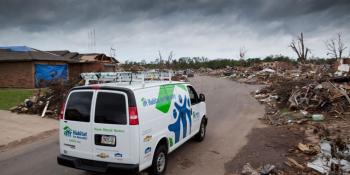
What is disaster response?
Disasters have a severe effect on people and property all over the world. Lives are lost, homes and livelihoods are destroyed, and those who survive must begin putting all of the pieces back together.
In the United States, government organizations like the Federal Emergency Management Agency are responsible for responding to disasters. According to the agency’s website, “FEMA’s mission is to support our citizens and first responders to ensure that as a nation we work together to build, sustain and improve our capability to prepare for, protect against, respond to, recover from and mitigate all hazards.”
Disasterassistance.gov outlines the categories of available federal help, from housing and legal counsel to various forms of disaster relief and living assistance.
Government agencies in other countries have procedures in place for responding to disasters as well.
Nongovernmental agencies also are quick to act in the wake of disaster. Organizations like the Red Cross and Habitat for Humanity work all over the world to help people recover after disasters strike.
Habitat for Humanity’s response focuses on addressing the housing needs created by disaster. Response programs might include emergency shelter kit distributions, home repairs, new home construction, and training in disaster response and risk reduction.
Local Habitats in communities all over the U.S. manage the response to a disaster affecting their service areas.
When a disaster occurs, Habitat’s disaster risk reduction and response team helps to coordinate actions with the local Habitat . The team provides support by linking local Habitat staff with other groups also involved in the response.
The disaster risk reduction and response team can also connect local staff with Habitat’s Disaster Corps volunteers. These volunteers are highly trained and skilled individuals who can move quickly to respond to an event and don’t require much supervision. The team also has mobile response units — vans loaded with tools and equipment for cleanup, repair and reconstruction — that can be sent into disaster-affected areas.
The scope of the support provided is generally proportionate to the level of impact on housing. Habitat’s disaster response work isn’t linear for every household, always moving from emergency shelters to temporary shelters to permanent ones. Rather, our response is tailored to the shelter needs of each family and leverages both their resources and the capacity of local groups responding to the disaster.
When Superstorm Sandy hit the northeast Atlantic coast in 2012, for example, Habitat’s Disaster Corps volunteers jumped into action to support debris management and clean-up. Habitat also coordinated an application for funding to benefit multiple local recovery efforts, including permanent reconstruction of homes.
Coordination is especially important in major disasters like Hurricane Katrina, where the damage is so widespread that it can be overwhelming for a local Habitat to attempt to handle alone. In response to that devastating event, Habitat’s collective efforts resulted in the start of construction on the first permanent home after the storm just six weeks after the hurricane hit shores. Habitat has since built, repaired or rehabbed more than 5,400 houses along the U.S. Gulf Coast.
To date, Habitat for Humanity’s disaster response work has served more than 220,000 households worldwide, building more than 70,000 new homes. It has also performed rehabs and repairs on more than 100,000 homes.
Learn more and donate today!
Subscribe to our monthly newsletter
Get our latest news, volunteer opportunities, DIY tips and other ways to get involved with Habitat for Humanity.
